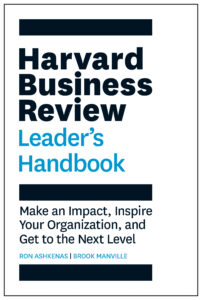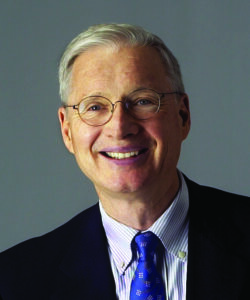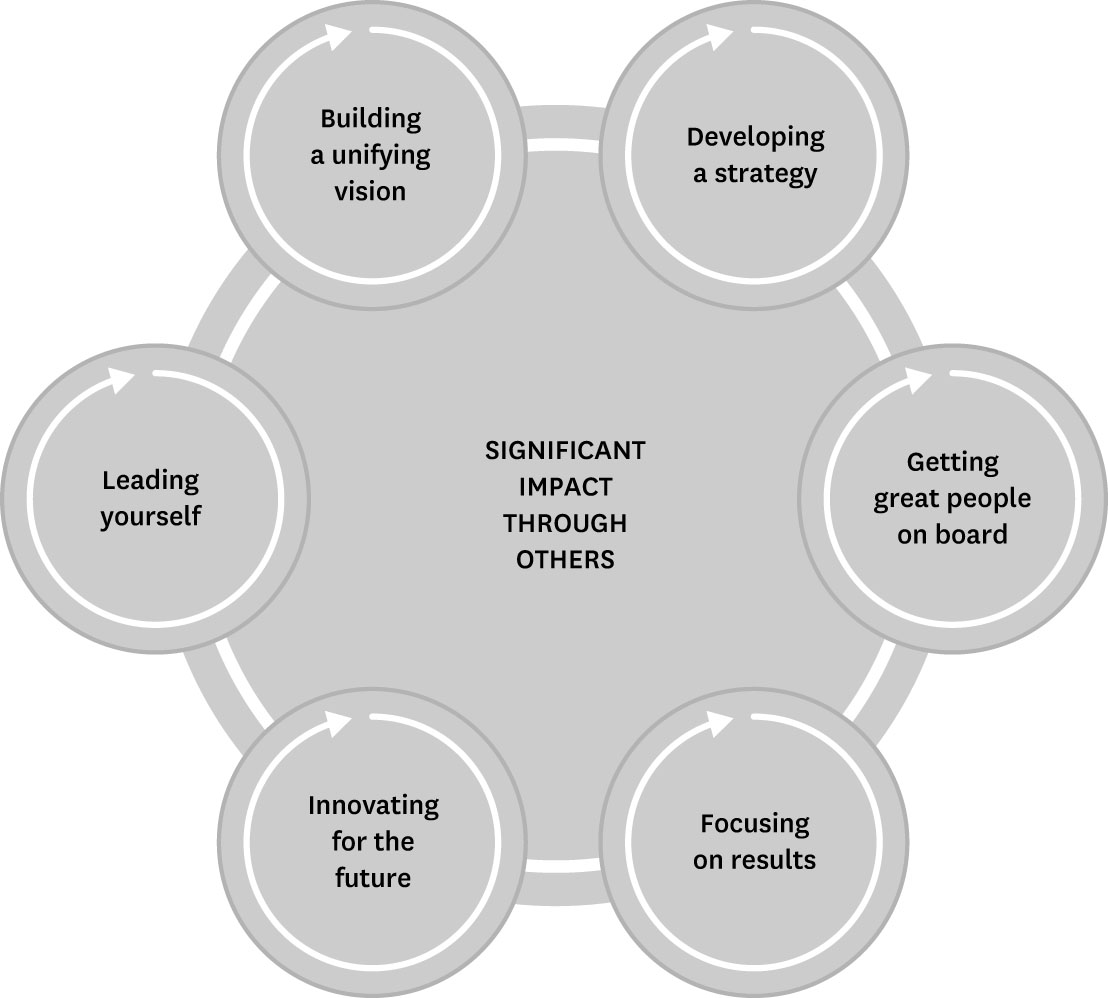Stand Out as Leader
To stand out and make a big impact as a leader, you need to be well-versed in fundamental leadership skills.
Ron Ashkenas and Brook Manville are the authors of a new book from Harvard Business Review Press entitled The HBR Leader’s Handbook: Make an Impact, Inspire Your Organization, and Get to the Next Level. The book is a back-to-basics primer for both aspiring and experienced leaders, which describes the fundamental leadership practices: Creating a unifying vision, shaping strategy, building a great team, driving for results, innovating for the future, and leading yourself. The authors, both respected leadership experts and consultants, based the book not only on their own experience but also on interviews with over 40 successful leaders and a review of the most enduring themes and seminal articles that have appeared in Harvard Business Review in the past several decades.
Back to Basics
Why a “back to basics” leadership book now? With so many new leadership books and articles every year, why a new Leader’s Handbook from Harvard Business Review?
Brook: We wrote this book to give the pendulum of “leadership” a needed push back towards its timeless and pragmatic origins: leadership defined as achieving a significant impact by building an organization of people working toward a common goal.
In recent years, leadership as a discipline has expanded to include not just a lot of gimmicky and ephemeral concepts but also a wide variety of basic self-improvement techniques: how to make checklists to order your day, how to stand before an audience to project authority, how to resist the temptations of too much social media. Such advice can be helpful but can distract rising professionals from the bigger picture of why leadership ultimately matters and what they should aspire to. We wanted to take leadership back to its historical meaning and show would-be leaders the value of tried and true practices that can help them make a real difference in whatever they are trying to accomplish with other people.
In addition, getting back to the fundamentals, as we write in our book, will heal several myths or misconceptions that have arisen about leadership: That there’s only one “model” of leadership, based on specific traits and behaviors; that leadership is only about one’s self and character, and not building, inspiring, and aligning an organization; that leadership is so different from “management” that leaders don’t have to understand operations and deliver regular results; that leadership no longer matters in a world of networks and less-hierarchical enterprises. Successful leaders, through history and into the most productive organizations today, demonstrate otherwise.
6 Practices to Help Leaders Grow
You focus on six practices that help leaders grow. It all starts with building a unifying vision. What are some of the elements of a vision that endures?
Ron: This might sound controversial, but the goal of a leader isn’t to build a vision that “endures” – but rather a vision that inspires people to move into action and get something done. So the vision should only endure as long as it takes to translate it into reality.
That being said, good visions lay out aspirations that usually can’t be accomplished in one or two years, or sometimes longer. They also can’t be accomplished by just working harder and doing more of the same things – they require new thinking, creativity, and joint effort – so working towards their accomplishment pushes the organization into new territory. Visions also need to be simple and tap into people’s emotions so that everyone is excited about working towards the vision in a meaningful way.
In the The HBR Leader’s Handbook, we share a number of examples of great visions – such as those at the World Bank (“Our dream is a world free of poverty”), MD Anderson Cancer Center (“We make cancer history”), and Nest (“We create the thoughtful home – a home that takes care of the people inside it and the world around it”). But we also emphasize that building a unifying vision isn’t just the purview of CEOs. Leaders at every level need to create visions for their teams that are aligned with the bigger vision – but that give their own people a meaningful target. For example, the head of a fulfillment center might have the vision of “getting the right products to the right people at the right time at the right cost,” and the leader of an auto dealership might have the vision of “helping families enjoy the experience of traveling together.”
Finally, we talk a lot in this section of the book about the fact that leaders don’t have to be the sole originators and creators of memorable visions. In many, if not most cases, great leaders tap into the wisdom of their people, their customers, and their partners to find a vision that has meaning for all of them, and that also will help the organization move boldly into the future. Orchestrating a process to align everyone around this kind of vision is what this leadership practice is all about.
5 Common Leadership Pitfalls
What are some of the key mistakes leaders make when developing a strategy?
Brook: Developing strategy today remains some combination of art and science, and success is never guaranteed. Gone are the days of creating lengthy and deeply detailed strategic plans. But successful leaders still follow some basic process of understanding the needs and opportunities about where and how to compete to serve customers distinctively and beat back rivals. The strategy that emerges from this kind of fundamental problem-solving process is what helps an organization to deliver value at scale.
In that context, there are five common pitfalls that trip up strategy-making leaders:
- Not properly assessing and understanding external needs and opportunities, including trends and changes in the environment that affect what customers are looking for.
- Not being realistic about the internal capabilities you will need to serve those customers in some distinctive manner.
- Not framing the different choices about which customers to serve and how to serve them, including the different costs and potential pay-backs.
- Not having the courage to decide on a limited number of the potential choices you have identified—and thus being unwilling to focus your strategy, and to stop doing some things. In other words, trying to be “all things to all people” is always a recipe for disaster.
- Finally, pursuing strategy as a static, academic exercise, instead of a dynamic learning process. An effective strategy process requires testing and experimenting with ideas (and sample customers themselves) and adjusting your choices of where and how to compete as you learn more along the way.
People is the third element. How do you see the social contract changing? What should leaders be aware of today that may be different from the past?
Ron: One of the things we emphasize in the book is that “people join organizations voluntarily, with the assumption that their participation is a two-way street: If they give their best effort to help achieve the collective goals, they expect to be rewarded in terms of compensation, growth, job satisfaction, relationships, and more.” Unfortunately, many leaders forget that they have to honor both sides of this contract. If they obsessively drive for performance goals in ruthless ways, they will leave a trail of bodies and unhappy people behind, which makes it impossible to sustain performance. On the other hand, if they are so concerned about making everyone happy that they avoid conflicts and hard decisions, they won’t get anything done. Leaders have to find the right balance between these two extremes.
The basics of this social contract really haven’t changed over the years – but what is changing is the balance of power. In the not-too-distant past, there were more people than jobs, so employers were able to push people to work harder without worrying too much about whether they would pick up and leave. Some of this even crossed the line into verbal, psychological or other kinds of abuse – all with the sense that the employee needed the job or the career opportunity. Today, the balance of power is shifting dramatically. Because of changing demographics (the aging out of baby boomers) and a robust economy, there are often more jobs than people to fill them. At the same time, Millennials are less concerned about staying with one company for an entire career, and social norms have made it unacceptable for leaders to abuse the people that work for them. The result of these changes, in our view, is that leaders now have to more seriously consider both sides of the social contract. They still need to push for results, give tough performance feedback, and hold people accountable; but they also have to make sure that the people who work for them feel a sense of satisfaction, safety, belonging, and growth. It’s not easy to get this balance right – but that’s the challenge that leaders face today.
Focus on Results
Focusing on results is one area that many think they are completely comfortable with. What are some of the best cultural practices to build this into your organization?
Ron: I agree that many leaders say they are completely comfortable with a focus on results, but it’s easier said than done. In reality the ability to improve performance – to get better results over and over again and build it into your culture – is one of the most under-developed leadership practices. The main reason why the focus on results is so difficult is that many leaders avoid truly challenging their people to step up their performance. They worry that the goals might be too tough, that people won’t be able to reach them, and then they might have to either back down or fire someone. Leaders also worry that their people know more about the work than they do, and can argue their way out of the goals, which might make them look weak. Leaders also get complacent when current results are seen as “OK.”
 One of the ways that leaders create a high-performance culture is to overcome this anxiety by orchestrating a series of 100-day challenges for the team. Instead of betting the farm on a massive improvement, break it into increments that have enough stretch that they can’t just be accomplished by working harder. But at the same time, make sure the challenges are focused enough that the team has a realistic chance of getting there. In the book, for example, we talk about how Seraina Maccia tripled the profitable premium revenue for XL Insurance’s North American Property and Casualty business by challenging teams to win a certain amount of profitable new business, in several previously untapped markets, in 100 days. This goal spurred the teams to experiment with new ways of bringing in business, such as getting underwriters out to the field to work directly with brokers. Based on these early successes, Maccia launched dozens of additional teams both to build on these new approaches, and to tackle additional opportunities – all of which contributed to tripling the business in three years.
One of the ways that leaders create a high-performance culture is to overcome this anxiety by orchestrating a series of 100-day challenges for the team. Instead of betting the farm on a massive improvement, break it into increments that have enough stretch that they can’t just be accomplished by working harder. But at the same time, make sure the challenges are focused enough that the team has a realistic chance of getting there. In the book, for example, we talk about how Seraina Maccia tripled the profitable premium revenue for XL Insurance’s North American Property and Casualty business by challenging teams to win a certain amount of profitable new business, in several previously untapped markets, in 100 days. This goal spurred the teams to experiment with new ways of bringing in business, such as getting underwriters out to the field to work directly with brokers. Based on these early successes, Maccia launched dozens of additional teams both to build on these new approaches, and to tackle additional opportunities – all of which contributed to tripling the business in three years.
In addition to the 100-day challenges, Maccia also used other approaches to build the high-performance culture, such as regular reviews, clear metrics, tough performance feedback and the willingness to remove people who weren’t hitting their goals, regular communication, and more. The centerpiece for focusing on results however is to actually achieve them, in short bursts, and then to do it over and over again. If leaders can build that way of thinking into their organizations, it will go a long way towards building a high-performance culture.
Innovation is the last practice. It is after results in the book, and many would say that it is the first to get cut when results are at risk. How do leaders best guard against this? How do you make innovation central to everything?
Ron: First of all, let me caution you about describing the leadership practices in a sequential way. Although the innovation chapter comes after the results chapter, that doesn’t mean it’s less important. In fact, in our introduction and throughout the book, we talk about the practices as being interwoven – like threads that form the fabric of leadership.
That being said, you are right that innovation is often given short shrift and investment, and it is reduced in tough times. It’s the leader’s job, however, to make sure this doesn’t happen for very long, if at all. Instead, as we describe, leaders need to focus both on today’s performance and tomorrow’s threats and opportunities. To do this, they need to proactively take a number of steps, such as create bandwidth for themselves and others so that they have time to focus on innovation, take an active portfolio approach to innovation by placing a variety of bets on projects that have different timeframes and characteristics, make frequent decisions to either kill projects or recalibrate investments, create incentives for innovation throughout the organization so that ideas emerge from anywhere, use a lean start-up approach to rapidly test new products and services, get feedback from customers, and make rapid adjustments or pivots. There’s a lot here for leaders to do, which is why we broke this out as a separate practice, and we used Thomson Reuters, led by CEO Jim Smith, as our case example of a company that has developed a very strong and sustaining approach to innovation.
4 Areas of Practice for Leaders
Finally, I love the section on leading yourself. Would you give readers a taste of your thinking? Why is self leadership critical, and not something to postpone?

Brook: Many leadership books focus solely on managing and improving one’s habits, skills and knowledge as the all-important essence. We agree such things are important, but not for their own sake—they matter for leadership, as we have defined it in its pragmatic and timeless sense—because they are critical to the leader’s success in building and inspiring an organization of people to work together for common goals.
We also believe that “leading yourself” entails more than the often-narrow concepts of self-improvement. For simplicity, but also comprehensiveness, we suggest four broad categories of practice that leaders should work on continually, and not just “later.” Each of these will ultimately add to a leader’s effectiveness in creating higher impact followership and organizational impact.
First is “knowing yourself,” which means understanding who you are, what you’re good at, and not so good at—all of which will be critical to engaging and inspiring others and helping you focus your efforts in the best possible way. For example, when Anne Mulcahy, whom we interviewed, was turning around Xerox in the early 2000s, she realized that she was not as strong on strategy as she needed to be – so she made sure that there were very good strategic thinkers on her senior team.
The second part of this practice is “growing yourself,” i.e. pursuing a targeted and intentional program to build needed skills, knowledge, and behaviors—especially through realtime practice and reflection. A number of leaders talked about putting themselves into tough, uncomfortable situations during the course of their careers so that they could learn new skills.
Third is “sharing yourself,” which involves contributing your energy, knowledge, and time in a strategic way to help other leaders you work with to grow themselves and create impact. This might mean being a mentor to someone else or joining a board or volunteering in the community, all of which are important for building the capabilities of others.

Fourth is “taking care of yourself,” which is intentionally managing the physical, emotional, and spiritual aspects of your own welfare, including aspects of your family, relationships and personal beliefs. Andrew Geczy, for example, the CEO of Terra Firma Capital Partners Ltd, told us about a yearly scorecard that he makes for himself regarding five dimensions of his life: personal health, relationships with family, relationships with friends, contributions to the community, and achievements at work. He then uses this to make conscious decisions about where to spend his time and set his priorities. We also cite a seminal HBR article by Clay Christensen called “How Will You Measure Your Life” in which he encourages leaders to use their goal-setting skills to establish metrics not just for work, but for their overall life.
So clearly these are all actions that can’t wait until later, which is why we positioned this leadership practice as co-equal with all the others.
For more information, see The HBR Leader’s Handbook: Make an Impact, Inspire Your Organization, and Get to the Next Level.


